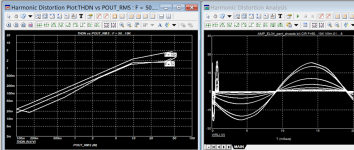if in 80 years nobody of the greatest manifacturer used Schade one reason exist.
I read the Deketh book pages 396 to 399 and only found issue with the load imposed on the driver stage for current Fdbk. What paragraph are you referring to?
UnSet fixes the loading with the Mosfet follower.
The problem I see with the usual resistive Schade scheme is that the N Fdbk current is being corrupted by the output tube grid drive voltage swing. The voltage across the feedback resistor is being varied by BOTH the plate voltage swing AND the grid drive voltage (with an INVERSION between them that causes 2nd harmonic distortion for each tube, 3rd H overall ). So the N Fdbk current is no longer purely proportional to the plate V. UnSet fixes that by isolating the tube drive from the N Fdbk. High gm output tubes could minimize the grid V effect, but they only came along late in the game.
Taking the "localized" N Fdbk back to the driver stage cathode or grids (crossed) fixes the corruption problem (more gain in loop minimizes drive V effect on Fdbk ), and that is what is seen in the classic commercial Amps using a localized loop (along with a global loop besides ).
Last edited:
Used by Philco in their 38-116 receiver, 1938.Just curious if anyone has built/analyzed anything like the original push-pull series feedback IT circuit.
Circuit lifted from Beitmans 1926-1938 Most Often Needed Radio Diagrams.
The only circuit of this kind in a reference of 235.
Attachments
so it is not Schade as described in the original circuitUnSet fixes the loading with the Mosfet follower.
the page you mentionedWhat paragraph are you referring to?
this is the first commercial use of the original Schade config I seeUsed by Philco in their 38-116 receiver, 1938.
Exactly 87 years ago, then nothing similar
Walter
Don't they know that electrons only like going from left to right in circuit diagrams? 😈Used by Philco in their 38-116 receiver, 1938
it depends, in UK goes right to leftDon't they know that electrons only like going from left to right in circuit diagrams?
Walter
This cct was devised by those left standing shortly afterDon't they know that electrons only like going from left to right in circuit diagrams? 😈
the Winslow, AZ crater was formed by a
large mass traveling at high velocity.🙂🙂
Oh man, were they lucky, I had to crawl out of that crater. There is something -wrong- with the Universe's chirality near there, L->Rdevised by those left standing
R->L
Cosmologists are saying now that the Universe is spinning slowly, that we must be inside a spinning black hole. Determines fundamental constants like left handed neutrinos, the way clocks turn, how phonograph records spin....
I was standing on a corner in Winslow Arizona, and it was a fine sight to see. I remember a girl in a flatbed Ford slowing down to take a look at me.
We may lose, and we may win, but those Philco engineers won't be here again.
I think the main reason you don't really see Schade's circuit used in commercial products is that there is a much simpler way to put series feedback around the output stage: cathode feedback.
A commercial amplifier designer can do some design work to determine how much feedback they want and then just manufacture an output transformer that has the right amount of feedback.
And then there are other schemes mentioned here that use some semiconductors.
I determined experimentally that even 100% feedback around the output stage didn't get distortion as low as I wanted, so I do series feedback to the driver stage cathode, also buffered by semiconductors, which prevents cathode current variations in the driver from contaminating the error signal from the amplifier output. I've never gotten distortion below .01% at 1W on my SET amp design, but I've come very close.
A commercial amplifier designer can do some design work to determine how much feedback they want and then just manufacture an output transformer that has the right amount of feedback.
And then there are other schemes mentioned here that use some semiconductors.
I determined experimentally that even 100% feedback around the output stage didn't get distortion as low as I wanted, so I do series feedback to the driver stage cathode, also buffered by semiconductors, which prevents cathode current variations in the driver from contaminating the error signal from the amplifier output. I've never gotten distortion below .01% at 1W on my SET amp design, but I've come very close.
Quite an achievement. Looks good on a Spec A.I've never gotten distortion below .01% at 1W on my SET amp design, but I've come very close.
But any practical loud speaker simply throws that away.
Handedness is a weird artifact of the deep unknowable world. Like time, it doesn't fit into either Einstein/classical/Newtonian/Maxwell physics. Evolded things like us have been iterated from many generations of pass/fail testing, and we are the descendants of the survivors. Those incapable or just unluckly, are not our ancestors - just old dead relatives.
All humans alive now are at least 50th cousins, and excluding the (genetically) isolated people of the Pygmy and non-Bantu-speaking strongly protected (for cultural reasons) people of Southern Africa, all modern humans are at least 32nd cousins.
Our (not human, but...) cousins, the people now called the Dali, the Neaderthal, etc. were close enough genetically to interbreed with our ancestors that left Africa during the 80kYA migration, and may have migrated into Asia as long ago as 400kYears ago. We (our ancestors, mostly) all stayed in Africa until the genetically significant time of about 80Kyears ago when humans spread out of Africa. We, all modern humans, are the ancestors of large dangerous hairless African apes, who, through luck and persistence, have dominated a planet.
Satanyana said that we forget our history at the price of our future (although he probably said it better).
We are all related, we are all cousins, live as family,
Chris
All humans alive now are at least 50th cousins, and excluding the (genetically) isolated people of the Pygmy and non-Bantu-speaking strongly protected (for cultural reasons) people of Southern Africa, all modern humans are at least 32nd cousins.
Our (not human, but...) cousins, the people now called the Dali, the Neaderthal, etc. were close enough genetically to interbreed with our ancestors that left Africa during the 80kYA migration, and may have migrated into Asia as long ago as 400kYears ago. We (our ancestors, mostly) all stayed in Africa until the genetically significant time of about 80Kyears ago when humans spread out of Africa. We, all modern humans, are the ancestors of large dangerous hairless African apes, who, through luck and persistence, have dominated a planet.
Satanyana said that we forget our history at the price of our future (although he probably said it better).
We are all related, we are all cousins, live as family,
Chris
Last edited:
I think is not so simplyI think the main reason you don't really see Schade's circuit used in commercial products is that there is a much simpler way to put series feedback around the output stage: cathode feedback.
If Walker, Leak, Radford, AR, VTL ,C-J, Scott,Fisher, etc didn’ use this config some reasons are there
What I think that this config is strictly related to original circuit and the purpose to use a cheap OT
With proper setting of circuit and the use of a very good iron the FB can be used with a low %. Around 10 dB is not high also using a pentode config.
Even I tested good circuit with 20dB and in the listening session they have had good performance
As usual the results comes from a good design
My personal idea
Walter
Indeed. I was mainly after good damping factor and low-enough distortion, but the results of the circuit surprised me. The goal of the circuit was to get good damping factor without having the output transformer in the loop. It seems to work well.Quite an achievement. Looks good on a Spec A.
But any practical loud speaker simply throws that away.
At this point, I just want to get less than .01% just to say I did it.
Are simulation so is not the reality.The simulation of the circuit
I am trying to find someone who have testes on desk this config.
I ma checking some different setting with different tubes and OT now only in s.e. and the results are not so good as expected
Walter
That circuit has been built. Damping and power are high. The feedback not crossing the output transformer makes everything more stable at high power. I have only tried the fully balanced pentode push-pull configurations.
This can be obtained with a proper project without any problems also including the FB loop out-in.The feedback not crossing the output transformer makes everything more stable at high power
The quality of project and OT is the secret, no way.
And still I can't see a proper test results done on desk.
Walter
Olde Schade Circuit Simple Analysis
Reduced to SE, the basic circuit is symmetrical
And most DC parts pulled out.
With the NFB as is the DF calcs out to 1.57.
A real circuit would lose a bit of that as a result of OPT resistances.
With the common application of the day, loudspeaker in an open
back console the DF was a big improvement. But the bean counters
of the day would not normally approve. 🙂 🙂
Reduced to SE, the basic circuit is symmetrical
And most DC parts pulled out.
With the NFB as is the DF calcs out to 1.57.
A real circuit would lose a bit of that as a result of OPT resistances.
With the common application of the day, loudspeaker in an open
back console the DF was a big improvement. But the bean counters
of the day would not normally approve. 🙂 🙂
Attachments
- Home
- Amplifiers
- Tubes / Valves
- Thoughts on the old Schade PP series feedback?


